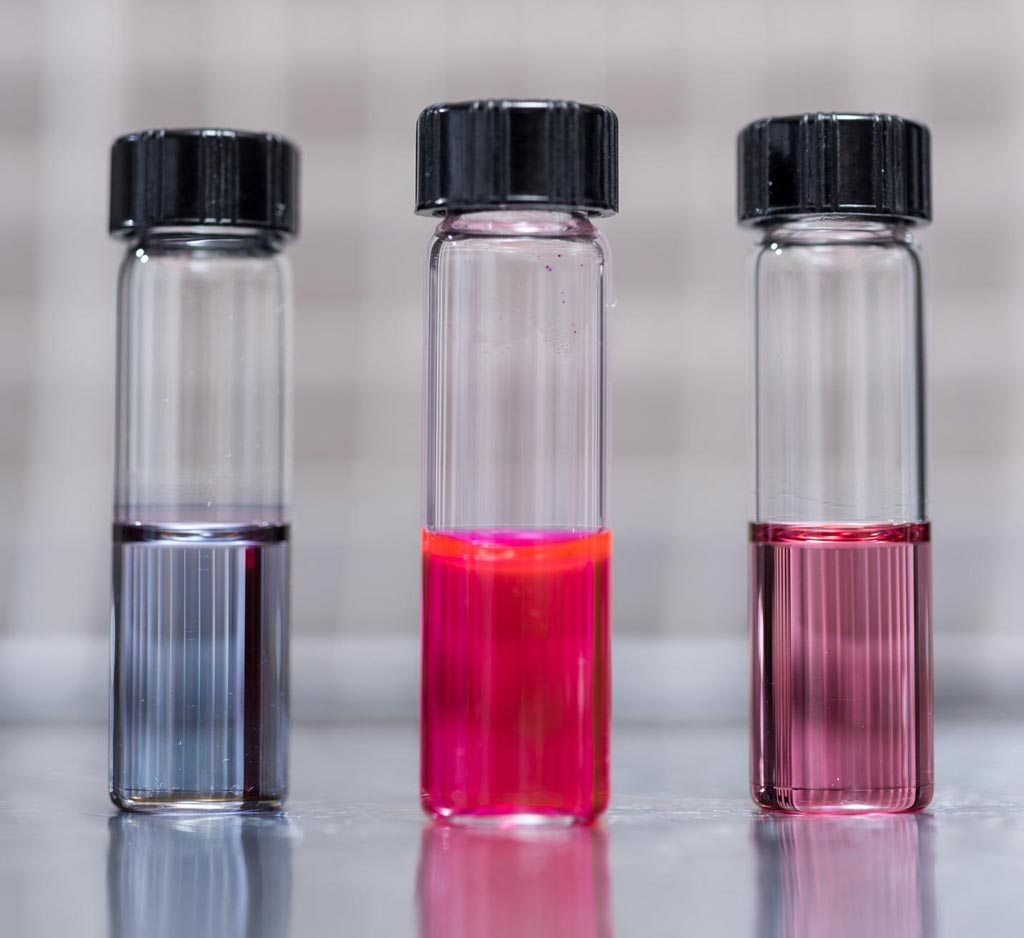Light-Sensitive Nanoparticles Designed for Smart Drug Release
By LabMedica International staff writers
Posted on 14 Feb 2018
A novel type of "smart" nanoparticles responds to light of specific wavelengths that causes the particles to assemble or disassemble, which enables the dynamic organization of the nanoparticles for in vitro drug release.Posted on 14 Feb 2018
The ability to dynamically organize functional nanoparticles (NPs) via the use of environmental triggers (temperature, pH, light, or solvent polarity) opens up important perspectives for rapid and convenient construction of a rich variety of complex assemblies and materials with new structures and functionalities.

Image: Vials containing samples of \"hairy\" nanoparticles: the right and left vials contain photo-responsive polymer-capped gold nanoparticles prior to and after self-assembly, respectively. The center vial shows dye released from self-assembled gold nanoparticles. The nanoparticles were made with light-sensitive materials that assembled and disassembled themselves when exposed to light of different wavelengths (Photo courtesy of Rob Felt, Georgia Institute of Technology).
In a study published in the January 31, 2018, online edition of the journal Proceedings of the [U.S.] National Academy of Sciences, investigators at the Georgia Institute of Technology (Atlanta, USA) described an unconventional strategy for crafting stable "hairy" NPs with light-enabled reversible and reliable self-assembly and tunable optical properties.
The "hairy" nanoparticles were fabricated around a tiny core of beta-cyclodextrin from which polymer chains of poly(acrylicacid)-block-poly(7-methylacryloyloxy-4-methylcoumarin) (PAA-b-PMAMC) were grown. This compound attracted water-soluble metal precursors, which utilized the space within the polymer hairs as nano-reactors to form gold nanoparticles. The investigators then added hairs made from the light sensitive hydrophobic monomer MAMC.
Light at a wavelength of 365 nanometers induced the nanoparticles to self-assemble through a photo-dimerization process, while the process was reversed when the particles were exposed to light at 254 nanometers.
“Under light, the assemblies of photo-sensitive nanoparticles separate over a period of hours at a rate that can be controlled by the intensity and wavelength of the light,” said senior author Dr. Zhiqun Lin, professor of materials science and engineering at the Georgia Institute of Technology. “Because the disassembly can be turned on and off at will, we could provide a timed release of the drug by controlling the short-wavelength light exposure. Once the polymer chains from adjacent gold nanoparticles begin to photo-crosslink, they bring nanoparticles together via a self-assembly process to generate large assemblies of nanoparticles. This process is completely reversible and can be repeated in many cycles.”
“We envision that these photo-responsive polymer-capped gold nanoparticles could one day serve as nano-carriers for drug delivery into the body using our robust and reversible process for assembly and disassembly,” said Dr. Lin. “Used in cancer therapy, this process could increase the impact of a treatment by heating the cancer cells while introducing the drug compound into the tumor.”
Related Links:
Georgia Institute of Technology









 Analyzer.jpg)




